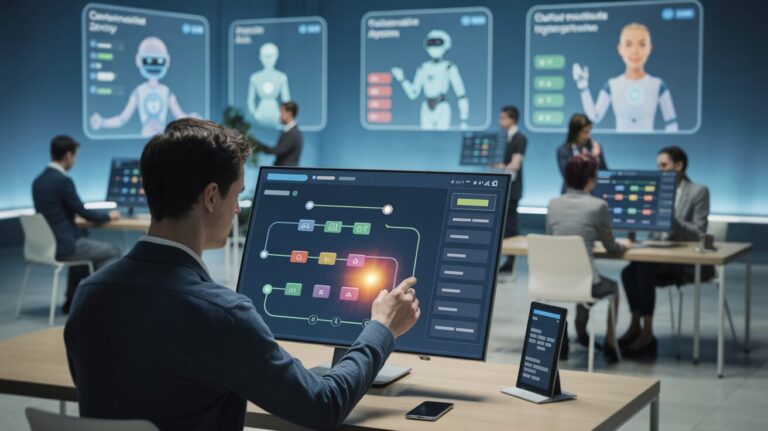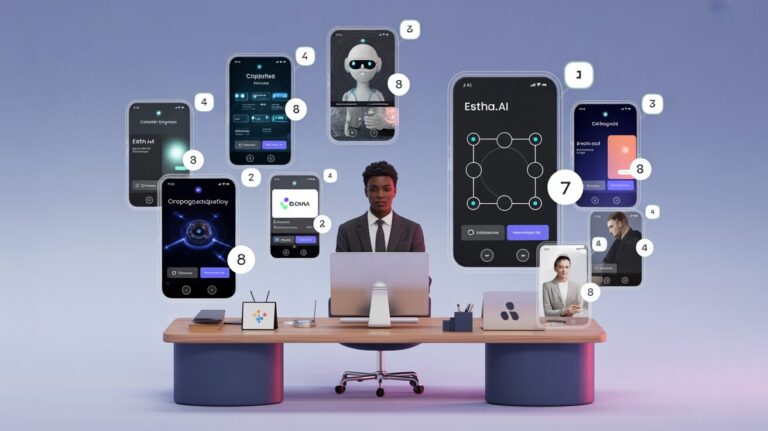Table Of Contents
- Introduction to AI in HR & Recruitment
- Why AI is Transforming HR & Recruitment
- Top AI Platforms for HR & Recruitment
- Key Features to Look for in HR AI Platforms
- Implementation Strategies for HR AI
- Future Trends in HR & Recruitment AI
- Conclusion
The human resources and recruitment landscape is undergoing a profound transformation, driven by the integration of artificial intelligence. From streamlining candidate screening to enhancing employee engagement, AI applications are revolutionizing how HR teams operate. Organizations adopting these technologies are experiencing dramatic improvements in efficiency, quality of hire, and overall workforce management.
However, with the proliferation of AI platforms in the HR space, selecting the right solution has become increasingly challenging. Each platform offers unique capabilities, specializations, and integration options. The ideal choice depends on your organization’s specific needs, technical capabilities, and strategic objectives.
In this comprehensive guide, we’ll compare the top AI platforms for HR and recruitment, examining their features, strengths, limitations, and ideal use cases. Whether you’re looking to enhance your talent acquisition process, improve employee onboarding, or develop more sophisticated HR analytics, this comparison will help you identify the solution that best aligns with your requirements.
AI Platforms Transforming HR & Recruitment
The Ultimate Comparison for 2023 and Beyond
Why AI is Revolutionizing HR
Candidate Sourcing
AI algorithms scan thousands of resumes in minutes, identifying qualified candidates with higher accuracy than manual methods.
Interview & Assessment
AI-powered platforms standardize interviews, analyze responses, and predict job performance with greater consistency.
Employee Development
Personalized learning recommendations and skill gap analysis support continuous professional growth throughout employee lifecycle.
Organizations using AI in HR report 20-50% reduction in time-to-hire and 75% decrease in recruitment costs.
Top AI Platforms Compared
| Platform | Key Strengths | Best For |
|---|---|---|
| Estha |
|
Organizations seeking customized HR AI tools without technical dependencies |
| HireVue |
|
High-volume recruitment with standardized interview processes |
| Paradox |
|
Organizations prioritizing candidate experience and communication |
| Eightfold |
|
Large enterprises with holistic talent management needs |
| Textio |
|
Organizations focused on inclusive hiring and employer branding |
Essential Features to Look For
Customization Flexibility
Solutions should adapt to your unique processes rather than forcing you to change workflows.
Integration Capabilities
Seamless connectivity with existing HR systems prevents data silos and streamlines workflows.
Ethical AI & Bias Mitigation
Advanced bias detection ensures fair treatment across all demographic groups.
Analytics & Reporting
Comprehensive dashboards that transform HR data into actionable strategic insights.
Future HR AI Trends
Hyper-Personalization
Individualized experiences for candidates and employees based on comprehensive data profiles.
Skills-Based Management
Transition from role-based to granular skills-focused talent strategies for greater workforce flexibility.
Democratized AI Development
No-code platforms empowering HR professionals to create custom AI solutions without technical expertise.
Transform Your HR & Recruitment Process Today
Create custom AI solutions for candidate screening, employee onboarding, and skills assessment without writing code.
© Estha.ai – Making AI Accessible to Everyone
Why AI is Transforming HR & Recruitment
The adoption of AI in HR departments is accelerating for compelling reasons. Traditional HR processes are often labor-intensive, subjective, and prone to unconscious biases. AI technologies address these challenges by automating routine tasks, providing data-driven insights, and enabling more objective decision-making.
Recent research by PwC reveals that 40% of HR functions in international companies are already using AI applications. Organizations implementing these solutions report a 20-50% reduction in time-to-hire, 75% decrease in recruitment costs, and significant improvements in quality of hire and retention rates.
Key areas where AI is making the most significant impact include:
Candidate Sourcing and Screening
AI algorithms can scan thousands of resumes within minutes, identifying candidates whose qualifications and experience match job requirements. This not only accelerates the screening process but also ensures qualified candidates aren’t overlooked due to human fatigue or oversight. Natural language processing capabilities allow these systems to understand context and semantic meaning in resumes, significantly improving matching accuracy.
Interview and Assessment
AI-powered interview platforms can analyze candidate responses, facial expressions, and speech patterns to provide insights into soft skills, personality traits, and potential cultural fit. These tools help standardize the interview process, ensuring all candidates are evaluated against consistent criteria. Some solutions also offer simulation-based assessments that predict job performance more accurately than traditional methods.
Onboarding and Employee Development
Personalized onboarding experiences guided by AI help new hires integrate more effectively. Learning recommendations based on role requirements and individual strengths accelerate productivity. AI systems can also identify skill gaps and suggest relevant training opportunities, supporting continuous professional development throughout the employee lifecycle.
Employee Engagement and Retention
Sophisticated sentiment analysis tools monitor employee satisfaction and identify potential retention risks before they escalate. By analyzing communication patterns, performance metrics, and engagement indicators, these systems enable proactive interventions to improve workplace experience and reduce turnover.
HR Analytics and Strategic Planning
Advanced analytics powered by AI transform HR data into actionable workforce insights. These capabilities support evidence-based decision-making around resource allocation, succession planning, and talent management. Predictive models can forecast hiring needs, identify future leadership candidates, and optimize workforce planning.
Top AI Platforms for HR & Recruitment
Estha: No-Code Custom HR AI Solutions
Estha stands out as a revolutionary no-code AI platform that empowers HR professionals to create custom AI applications without technical expertise. Unlike other platforms that offer fixed-feature sets, Estha enables users to build tailored solutions addressing their specific recruitment and HR management challenges.
With Estha’s intuitive drag-drop-link interface, HR teams can rapidly develop specialized AI tools such as candidate screening chatbots, employee onboarding assistants, and interactive training modules. The platform’s flexibility allows HR departments to adapt their AI applications as needs evolve, without dependency on IT resources or external vendors.
Key advantages for HR departments include:
- Custom HR Chatbots: Create conversational interfaces that answer candidate questions, collect application information, and screen initial qualifications—all reflecting your company’s unique voice and hiring criteria.
- Personalized Onboarding Assistants: Develop AI guides that help new employees navigate company policies, procedures, and resources at their own pace.
- Interactive Skills Assessments: Build role-specific evaluation tools that adapt to candidate responses, providing deeper insights than standardized tests.
- Training and Development Solutions: Design AI-powered learning experiences tailored to different roles, departments, and individual development needs.
Most importantly, Estha’s ecosystem includes EsthaLEARN for HR-specific AI training, EsthaLAUNCH for scaling custom HR applications across the organization, and EsthaSHARE for distributing tools between departments or even monetizing successful HR solutions externally. For organizations seeking to innovate their HR processes with AI while maintaining control over their unique workflows, Estha provides an ideal balance of power and accessibility.
HireVue: AI-Powered Interview Platform
HireVue specializes in transforming the interview process through AI-enhanced video interviews and assessments. The platform uses sophisticated algorithms to analyze candidate responses, facial expressions, and language patterns to evaluate skills, personality traits, and potential job fit.
Core features include:
- On-Demand Video Interviews: Candidates record responses to standardized questions, allowing recruiters to review at their convenience.
- AI-Driven Assessments: Pre-built and customizable game-based assessments measure cognitive abilities, technical skills, and soft skills.
- Predictive Analytics: Algorithms identify candidates most likely to succeed in specific roles based on performance patterns from top employees.
- Structured Interview Builder: Tools for creating consistent interview experiences that align with job requirements and reduce bias.
HireVue excels in high-volume recruitment scenarios where standardization and efficiency are priorities. However, its effectiveness depends on proper configuration and ongoing calibration to avoid algorithmic bias. Organizations must carefully implement and monitor the system to ensure fair evaluation across diverse candidate pools.
Paradox: Conversational AI Assistant
Paradox offers Olivia, an AI recruiting assistant that specializes in conversational interactions throughout the candidate journey. This solution streamlines communication with applicants through natural language processing capabilities that simulate human conversations.
Distinctive capabilities include:
- Candidate Screening: Conducts preliminary qualification conversations via text or web chat.
- Scheduling Automation: Coordinates interviews between candidates and hiring teams without manual intervention.
- Event Recruitment: Manages registration, check-in, and follow-up for hiring events and career fairs.
- Onboarding Communication: Guides new hires through pre-start documentation and orientation processes.
Paradox particularly benefits organizations with high-touch recruitment processes requiring frequent candidate communication. The platform significantly reduces administrative workload for recruitment teams while improving candidate experience through responsive, 24/7 interaction. Integration capabilities with existing ATS and HRIS systems further enhance its value in complex HR technology environments.
Eightfold: Talent Intelligence Platform
Eightfold leverages deep learning algorithms to create a comprehensive talent intelligence platform. Its core innovation is a sophisticated AI engine that analyzes billions of employment data points to identify skills, potential, and career trajectories.
Key functionalities include:
- Talent Acquisition: Matches candidates to positions based on capabilities and potential rather than just keywords.
- Internal Mobility: Identifies development opportunities and career paths for existing employees.
- Diversity & Inclusion: Reduces bias in hiring and promotion decisions through objective skills assessment.
- Workforce Planning: Forecasts talent needs and identifies skill gaps for strategic planning.
Eightfold’s strength lies in its holistic approach to talent management across the entire employee lifecycle. The platform excels in large organizations seeking to implement data-driven talent strategies that balance external recruitment with internal development. Its implementation requires substantial historical HR data to maximize predictive accuracy, making it most valuable for established enterprises with robust data resources.
Textio: AI Writing Platform for Recruitment
Textio specializes in augmented writing for recruitment communications. The platform analyzes job descriptions, outreach messages, and other recruitment content to optimize language for effectiveness, inclusivity, and brand alignment.
Notable features include:
- Real-time Writing Guidance: Provides suggestions as users draft content to improve engagement and eliminate biased language.
- Performance Prediction: Forecasts how job postings will perform with different demographic groups.
- Brand Tone Analysis: Ensures recruitment communications maintain consistent voice and values.
- Comparative Analytics: Benchmarks content performance against industry standards and competitors.
Textio delivers exceptional value for organizations focused on employer branding and diversity recruitment goals. By improving the quality and inclusivity of written communications, the platform helps attract broader candidate pools and enhance application rates from underrepresented groups. However, its specialized focus means it typically complements rather than replaces broader HR AI solutions.
Key Features to Look for in HR AI Platforms
When evaluating AI platforms for HR and recruitment, several critical capabilities determine their effectiveness and return on investment. Consider these essential features during your selection process:
Customization Flexibility
The ability to tailor the platform to your organization’s specific processes, terminology, and requirements is paramount. Rigid, one-size-fits-all solutions often fail to address unique organizational needs. Platforms like Estha excel here by providing no-code customization tools that empower HR teams to design applications matching their exact workflows, without technical dependencies.
Integration Capabilities
Seamless integration with existing HR systems—including applicant tracking systems, HRIS, performance management tools, and learning platforms—prevents data silos and streamlines workflows. Look for pre-built connectors to popular systems and robust API capabilities for custom integrations. This ensures your AI platform enhances rather than complicates your HR technology ecosystem.
Ethical AI and Bias Mitigation
Advanced bias detection and mitigation features are essential to ensure fair treatment across demographic groups. Evaluate how platforms address potential discrimination in algorithms, what transparency they provide into decision-making processes, and how they handle sensitive demographic data. Responsible AI practices should be evident in both product design and company documentation.
Scalability and Performance
The platform should accommodate your organization’s growth without performance degradation. Consider how it handles increasing data volumes, user numbers, and complexity of operations. Cloud-based solutions typically offer better scalability than on-premises alternatives, with the ability to adjust resources based on demand fluctuations.
User Experience and Adoption Support
Intuitive interfaces for both HR professionals and employees/candidates significantly impact adoption rates. Evaluate the learning curve for different user types and available training resources. The most effective platforms balance sophisticated capabilities with accessible, user-friendly design that encourages widespread utilization.
Analytics and Reporting
Comprehensive analytics capabilities transform HR data into actionable insights. Look for customizable dashboards, predictive analytics features, and the ability to track key performance indicators specific to your organization’s goals. The most valuable platforms provide both operational metrics and strategic workforce intelligence to support decision-making at all levels.
Data Security and Compliance
Robust security measures and compliance with relevant regulations are non-negotiable when handling sensitive employee and candidate data. Evaluate encryption standards, access controls, data residency options, and compliance certifications (GDPR, CCPA, etc.). Transparent data governance policies and regular security audits indicate a vendor’s commitment to protecting your information.
Implementation Strategies for HR AI
Successfully implementing AI in HR requires thoughtful planning and change management. Organizations that achieve the greatest ROI from these technologies typically follow these proven implementation strategies:
Start with High-Impact Use Cases
Begin your AI journey by addressing specific pain points with clear metrics for success. For example, if your organization struggles with resume screening volume, implementing an AI solution for initial candidate filtering can deliver immediate value. This targeted approach demonstrates quick wins, builds organizational confidence, and creates momentum for broader adoption.
For many HR departments, building custom AI solutions with no-code platforms like Estha enables rapid deployment of specialized applications addressing your most pressing challenges. This approach combines the benefits of customization with the speed of pre-built solutions.
Secure Cross-Functional Buy-In
Successful AI implementation requires collaboration across HR, IT, legal, and business units. Involve stakeholders early in the process to address concerns, incorporate diverse perspectives, and ensure the solution meets multifaceted organizational needs. Executive sponsorship is particularly crucial for navigating resource allocation and change management challenges.
Invest in Training and Change Management
Comprehensive training programs help HR staff and managers maximize AI tools’ potential. Beyond technical instruction, focus on developing new skills for working alongside AI—such as interpreting analytics, providing human oversight of automated processes, and communicating the balance of AI and human judgment to employees and candidates.
Implement Ethical Governance
Establish clear protocols for AI oversight, including regular algorithm audits, performance reviews against fairness metrics, and processes for challenging automated decisions. Transparency about how AI is used in HR processes builds trust with employees and candidates while mitigating legal and reputational risks.
Plan for Continuous Improvement
AI systems become more effective over time with proper management and refinement. Establish feedback loops to capture user experiences, monitor performance metrics, and regularly retrain algorithms with new data. Schedule quarterly reviews to assess impact against objectives and identify opportunities for expanding or enhancing AI capabilities.
Future Trends in HR & Recruitment AI
The evolution of AI in HR is accelerating, with several transformative trends emerging that will reshape talent management practices:
Hyper-Personalization
Next-generation HR AI will deliver increasingly personalized experiences for both candidates and employees. From customized career development recommendations to individualized benefits suggestions, these systems will leverage comprehensive data profiles to tailor every aspect of the employment relationship. The ability to create personalized AI assistants using platforms like Estha will enable HR teams to provide individually relevant guidance at scale.
Augmented Decision-Making
Rather than replacing human judgment, advanced AI will increasingly serve as a decision-support tool for HR professionals. These systems will present relevant data, identify patterns, suggest options, and predict outcomes—while leaving final decisions to human expertise. This collaborative approach combines AI’s analytical power with human empathy and contextual understanding.
Skills-Based Talent Management
Traditional role-based approaches to hiring and development are giving way to skills-focused strategies. AI platforms will increasingly map granular skill data across the workforce and candidate market, enabling precision matching between capabilities and needs. This shift supports more flexible talent deployment, cross-functional mobility, and targeted skill development.
Ambient Intelligence in the Workplace
AI will become increasingly embedded in workplace environments through sensors, wearables, and smart infrastructure. These systems will optimize workspace utilization, monitor well-being indicators, and facilitate collaboration—while respecting privacy concerns. HR teams will play a crucial role in establishing governance frameworks for these technologies.
Democratized AI Development
No-code and low-code platforms will continue empowering HR professionals to create their own AI applications without technical expertise. This democratization enables rapid innovation tailored to specific organizational needs. HR teams using platforms like Estha can experiment, iterate, and deploy custom AI solutions addressing emerging challenges without dependency on IT resources or vendor development cycles.
Conclusion
The landscape of AI applications for HR and recruitment continues to evolve rapidly, offering increasingly sophisticated solutions for talent acquisition, development, and management. Each platform reviewed in this comparison brings unique strengths to address different aspects of the HR function.
For organizations seeking comprehensive solutions, the choice between platforms should be guided by specific business requirements, existing technology infrastructure, and strategic HR priorities. While specialized tools like HireVue and Textio excel in their respective niches, flexible platforms like Estha provide the adaptability to create custom applications addressing your organization’s unique challenges without technical dependencies.
As AI becomes increasingly central to HR operations, the most successful organizations will be those that thoughtfully integrate these technologies into their people processes. The goal should not be automation for its own sake, but rather augmenting human capabilities to create more effective, engaging, and equitable workplaces.
When implemented with clear objectives, appropriate change management, and ongoing governance, AI platforms can transform HR from an administrative function to a strategic driver of organizational success. The future of HR lies not in choosing between human judgment and artificial intelligence, but in creating powerful synergies between the two.
Ready to Transform Your HR & Recruitment Process?
Create your own custom AI applications for candidate screening, employee onboarding, skills assessment, and more—without writing a single line of code.



